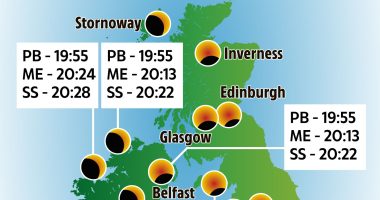
THE biggest asteroid to get near Earth this year will fly by our planet this week.
The space rock named 7335 (1989 JA) will soar within 2.5million miles of Earth on May 27, according to Nasa.
According to Nasa’s close approaches database, the rock is up to 1.1 miles wide, which makes it four times bigger than the Empire State Building – or as tall as 350 giraffes stacked on top of each other.
Though it’s classified as “potentially hazardous” because it’ll come within 4.65 million miles of Earth, Asteroid 7335 does not pose any immediate threat to our planet.
The space object is expected to fly by on Friday at 10.26am EST, and budding astronomers can try and spot the asteroid a couple of days before with a backyard telescope, according to Earth Sky.
The asteroid should be reflecting sunlight on May 25, making it easier to spot as it appears like a slow-moving star.
You can watch the celestial event on the Virtual Telescope Project’s live stream, which will start on Thursday evening.
Read our Asteroid 7335 live blog for the latest news and updates…
-
How asteroids get their names
When it comes to naming asteroids, the International Astronomical Union’s Committee on Small Body Nomenclature is lenient.
As a result, there’s a massive space rock named Mr Spock circling the Sun after the Star Trek figure.
There is also another space rock named after rock musician Frank Zappa.
There are even more solemn memorials, like the seven asteroids named after the crew of the Space Shuttle Columbia, which perished in 2003.
Asteroids are also given names based on places and other things, according to NASA.
-
Did an asteroid kill the dinosaurs?
The extinction of the dinosaurs was definitely caused by an asteroid impact, according to a team of scientists who were evaluating whether the newer theory that volcanoes led to their demise was accurate.
The researchers used a variety of methods to assess ancient temperature records and the amount of greenhouse gases that could have been in the atmosphere.
According to the study results, volcanic gasses may have still played a role in the decline of the dinosaurs.
-
How to spot the huge asteroid
According to Earth Sky, budding astronomers can try and spot the asteroid a couple of days before May 27 with a backyard telescope.
The asteroid should be reflecting sunlight on May 25, making it easier to spot as it appears like a slow moving star.
You’ll need to face south in the late evening and angle your telescope to the left of the Hydra constellation if you want to try and see the giant space rock.
-
‘Potentially hazardous’ asteroids explained
Nasa’s Center for Near Earth Object Studies (CNEOS) explains on its website: “Potentially Hazardous Asteroids (PHAs) are currently defined based on parameters that measure the asteroid’s potential to make threatening close approaches to the Earth.”
Large fast-moving space objects that come within 4.65 million miles of Earth are considered to be “potentially hazardous” by cautious space organizations.
One small change to their trajectories could spell disaster for Earth.
-
When to look up revealed
Nasa says the asteroid should pass Earth at around 14:26 UTC, which is 10.26 ET on Friday, May 27.
-
Asteroid 7335 is ‘potentially hazardous’
An asteroid of this size would cause some serious damage if it hit Earth.
The massive space rock is “potentially hazardous” by Nasa’s standards, as it comes within 4.65 million miles of Earth.
However, there’s no need to panic as Asteroid 7335 (1989 JA) should fly by Earth at a distance of about 2.5million miles away.
-
Asteroid 7335 expected to make ‘close approach’
Nasa expects Asteroid 7335 (1989 JA) to make a close approach to our planet on May 27
The giant space rock is predicted to be up to 1.1 miles long.
By comparison, New York’s Empire State Building stands at 1,454 feet tall – making the asteroid four times the size of the iconic building.
-
Asteroid 7335 expected to make ‘close approach’
Nasa expects Asteroid 7335 (1989 JA) to make a close approach to our planet on May 27
The giant space rock is predicted to be up to 1.1 miles long.
By comparison, New York’s Empire State Building stands at 1,454 feet tall – making the asteroid four times the size of the iconic building.









